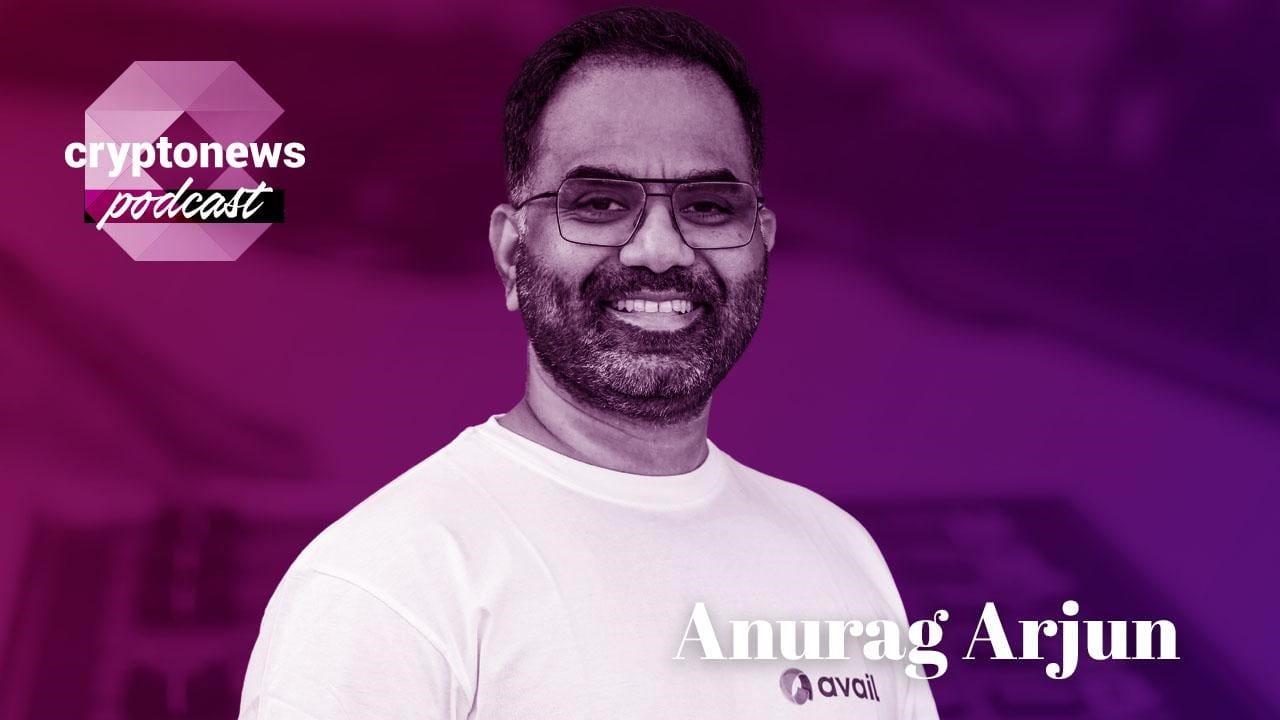Anurag Arjun, Co-founder of Avail, on Scaling Ethereum, The Future of L2s, Rollups, and Why Crypto Needs a Unification Layer | Ep. 338

In an exclusive interview with Cryptonews, Avail co-founder Anurag Arjun discussed rebranding Matic to Polygon and establishing Avail to provide the infrastructure for future crypto.
Blockchain’s future is rollups, he argued, and we are about to see many more of them.
To support that development, Avail is developing two essential components: the data availability (DA) layer, Avail DA, and the unification layer, Nexus.
Moving Beyond PoS
Back in 2017, when the team started working on the Matic Network, it was far smaller than what Polygon is now, Arjun told Cryptonews.
It was a small team with very little funding to work with.
“So the two years [until 2019] was a big struggle. It was a really tough initial couple of years,” Arjun said. “But you have to go through fire to make something really big.”
In 2020, the team rebranded Matic into Polygon, moving beyond the Proof-of-Stake (PoS) chain itself.
They took on more products, started crafting their ZK rollup strategy, acquired other teams, and started working on Avail.
That said, the MATIC token was very strongly correlated to the POS chain. “It is kind of a historical artifact that the token is called Matic.”
Arjun added that it would’ve been “too much of a hassle” at the time to change the token name as it was already listed on exchanges, among other things.
Meanwhile, the team has initiated the upgrade from MATIC to POL.
The Future is Rollup
Arjun came to the realization that the way in which we construct blockchains is going to change “massively.”
“Every new blockchain is mostly going to be a rollup,” he remarked.
Even before Avail was started within Polygon, it became increasingly clear to Arjun that data availability was a problem. It needed a solution.
“Any kind of off-chain scaling solution, especially rollups, need to have huge amounts of data availability throughput but also very easy ways to verify that,” he said.
Then, in 2019-2020, Ethereum also released its rollup-centric roadmap.
A rollup is a Layer-2 scaling solution that processes transactions away from the main blockchain.
Before rollups, people would just construct different L1s. And each one needed to have a validator set, a token, a crypto-economic security, and much more.
However, rollups opened up the possibility of having one base layer and an unlimited number of rollups built on top of it, inheriting the crypto-economic security of the base layer.
The POL token upgrade is now live on Ethereum mainnet.
Polygon 2.0, released this summer, is a roadmap for scaling Ethereum to build the Value Layer of the Internet. POL unlocks that future.
POL is a next-generation token that can power a vast ecosystem of ZK-based L2 chains.… pic.twitter.com/gmrsu0ZqLz
— Polygon | Aggregated (@0xPolygon) October 25, 2023
Rollups are separate blockchains, Arjun added.
There are already many blockchains that debuted as rollups and many more will come.
“And these Rollups need not necessarily be EVM Rollups,” he said. “The beauty of the rollup construct is that this can be anything.”
Therefore, there is a need for infrastructure to power this rollup-centric future. “And that’s the real idea of Avail,” Arjun stated.
The Avail team wanted to create off-chain systems that would “handle a bunch of transactions and then provide this proof back to Ethereum.”
Crypto Needs a Unification Layer
Avail encompasses two essential components, the co-founder said.
The first is Avail DA, which is going to mainnet soon.
Rollups require access to a base layer that has enough data availability, throughput, and verifiability, Arjun explained.
Ethereum’s roadmap includes Danksharding, which aims to increase data availability and throughput, among other things.
It involves something called data availability sampling.
It is essential to build the kind of support that rollups need at a global scale. This is what Avail has been working on for over three years now. “And it is the only project which has implemented data availability sampling with a validity proof-based approach,” Arjun said.
While it will take years before Danksharding becomes available, given Ethereum’s size, Avail already has Avail DA, he added.
“You’re really going to need this scaling infrastructure for rollups, and that is what Avail DA really provides,” the co-founder argued.
But there is an issue. “We certainly need to transition to this more rollup-centric architecture, but the UX fragmentation is becoming very real.”
Therefore, the team decided to connect rollups and build out a more high-level interoperability layer between them all.
This is where the second component of Avail comes in: Avail Nexus.
It “really builds this shared notion of validity between these rollups so that they can talk to each other.”
Once built, users will not need to worry about the chain infrastructure beneath it. They will move between the chains seamlessly.
Validity Proofs
Avail DA uses validity proofs (KZG commitments) so that developers and users don’t need to trust Avail that data is available, they can verify it for themselves.
Once a validity proof is generated it becomes computationally efficient to prove and verify,… pic.twitter.com/O8baqYbjxi
— Avail (@AvailProject) May 28, 2024
Avail Nexus – A ZK Rollups Built for Cross-rollup and Cross-ecosystem Settlement
Spinning up rollups is becoming easier than ever at this point. But to help them interact with each other across ecosystems? It’s not as easy at the moment.
That’s why we are building Avail… pic.twitter.com/lcB0X2ds6h
— Avail (@AvailProject) March 1, 2024
“And that is what we refer to as the unification because you don’t have to deal with the fragmentation of these chains,” Arjun concluded.
The Avail Nexus MVP version, once ready, will showcase this abstraction of chains, or the unification element, by connecting a Polygon zkEVM chain with a zkSync chain, enabling users to do cross-chain transactions.
____
That’s not all.
In this interview, Arjun also discussed:
- work on Plasma in 2017, one of the first off-chain solutions to scale Ethereum;
- co-founding Matic Network / Polygon in 2017;
- why Layer 1 blockchains are not the future of the industry;
- the necessity of a unification layer in the context of a rollup-centric future;
- preparing to launch Avail DA and Avail Nexus;
- incoming developments for Avail.
You can watch the full podcast episode here.
__________
About Anurag Arjun
Anurag Arjun is a seasoned entrepreneur who has founded several successful startups across diverse industries, ranging from cash flow lending to regulatory tech.
With a strategic move into the blockchain space in 2017, he co-founded Matic Network, which has since evolved into Polygon, a platform for scaling Ethereum.
In 2020, Arjun spearheaded the development of Avail, a solution within the Polygon ecosystem that empowers developers to create fast, efficient, and scalable applications.








